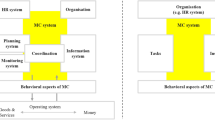Abstract
This paper is written by a manager working within a food manufacturing business specialising in the production of snack foods. It is based on a manager’s reflections and shows that the ‘command and control’ management logic (Seddon, Freedom from command and control: a better way to make the work work. Vanguard Education Ltd., Buckingham, 2003) can cause as many problems in manufacturing as it does in service organisations. The paper details how far command and control thinking had driven the business away from doing what its customers actually wanted. Although this paper will look particularly at this specific business, the findings are meant to be representative of what, in the author’s experience, are typical command and control discussions in conventionally managed organisations. The paper will describe the business’ background, its culture and the existing state of affairs. The organisation will be looked at from two perspectives: the business managers’ perspective and the perspective of the people in the work (front line workers and their line managers). The paper will then discuss the current business logic and its impact. It will examine what it was like to work in this system. The paper will go on to look at the model for ‘Check’ (Seddon 2003, p. 112) and its application in manufacturing, before detailing what the managers in the business would have seen if they had applied the model. Finally, it will describe what improvements could have been expected through the move to a logic built on systems thinking principles.




Similar content being viewed by others
References
Ackoff R (2004) Transforming the systems movement paper. Downloadable from http://www.acasa.upenn.edu/RLAConfPaper.pdf. Accessed 12/03/12
Ashby WR (1958) Requisite variety and its implications for the control of complex systems. Cybernetica 1(2):83–99
Darlington J, Francis M, Found P (2008) Flow accounting and LEAN enterprise. CUIMRC Working Paper Series (WP147). Cardiff University Innovative Manufacturing Research Centre (CUIMRC), Cardiff
Deming WE (1982) Out of the crisis. MIT Press, Cambridge
Deming WE (1994) The new economics: for industry, government education. MIT Press, Cambridge
Jackson M, Johnston N, Seddon J (2007) Evaluating systems thinking in housing. J Oper Res Soc 59:186–197
Johnson HT (2007) Management by financial targets isn’t lean. Manufacturing Engineering, December 2007, pp1-5. Downloadable from http://www.blnz.com/news/2008/05/13/Management_Financial_Targets_Isnt_Lean_2815.html. Accessed 3/8/12
Middleton P (ed) (2010) Delivering public services that work (volume 1): systems thinking in the public sector—case studies. Triarchy Press, Axminster
Office of the Deputy Prime Minister (ODPM) (2005) A systematic approach to service improvement evaluating systems thinking in housing. ODPM Publications, London
Ohno T (1988) Toyota production system. Productivity Press, Portland, Oregon. Translated from Japanese original, first published 1978
Pell C (ed) (2012) Delivering public services that work (volume 2): the Vanguard Method in the public sector—case studies. Triarchy Press, Axminster
Scholtes PR (1998) The leader’s handbook: making things happen, getting things done. McGraw-Hill, London
Seddon J (2003) Freedom from command and control: a better way to make the work work. Vanguard Education Ltd., Buckingham
Seddon J, O’Donovan B, Zokaei K (2011) Rethinking Lean Service. In: McIntyre M, Parry G, Angelis J (eds) Service design and delivery. Springer, New York
Senge P (2006) The fifth discipline. Random House Business Books
Stern S (2009) Fond farewell to a brilliant thinker. Financial Times 09/11/09. http://www.ft.com/cms/s/0/0168c7de-cd7e-11de-8162-00144feabdc0.html#axzz22Hyp8bBK. Accessed 01.08.12
Vargo SL, Lusch F (2004) Evolving to a new dominant logic for marketing. J Market 68(January 2004):1–17
Watts J (2010) The system is always greater than the parts: Using the Theory of Constraints and Factory Physics to transform manufacturing operations. In: Zokaei K, Seddon J, O’Donovan B (eds) Systems thinking: from heresy to practice. Palgrave Macmillan, Basingstoke
Wheeler D (2000) Understanding variation: the key to managing chaos. SPC Press, Knoxville
Zokaei K, Seddon J, O’Donovan B (2010) Systems thinking: from heresy to practice. Palgrave Macmillan, Basingstoke
Author information
Authors and Affiliations
Corresponding author
Rights and permissions
About this article
Cite this article
Watts, J. The Perils of Command and Control. Syst Pract Action Res 27, 75–89 (2014). https://doi.org/10.1007/s11213-012-9246-8
Published:
Issue Date:
DOI: https://doi.org/10.1007/s11213-012-9246-8




